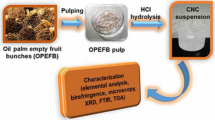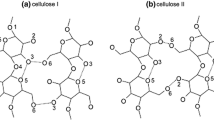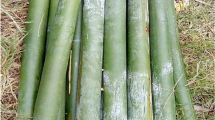Abstract
Nanocrystalline cellulose (NCC) was isolated from a totally chlorine free (TCF) bleached oil palm empty fruit bunch (OPEFB) pulp via acid hydrolysis using a 58 % sulfuric acid concentration and ultrasonic treatment. The effects of acid concentration and hydrolysis time were investigated. Characterization of OPEFB–NCC was carried out using TEM, FTIR, 13C-NMR, XRD, zeta potential and TGA. The optimal hydrolysis time was 80 min as indicated by the leveling off of the OPEFB–NCC dimensions (length 150 nm and diameter 6.5 nm) with no significant loss of crystallinity at this point. The presence of a shoulder peak at 1231 cm−1 (assigned to a sulfate group) in the FTIR spectrum of NCC is indicative of a successful esterification. This is further corroborated by the 13C-NMR analysis whereby the distinct C4 amorphous and crystalline peaks present in OPEFB–TCF pulp had almost disappeared and the cluster of signals for C2, C3, C5, and a well separated signal of C6 had merged into one single peak in the OPEFB–NCC sample. These observations allude to most of the amorphous region having been removed and to the strong possibility of sulfonation having not only occurred on the C6, but also on C2 and C3. OPEFB–NCC isolated over shorter hydrolysis time was more thermally stable; however, the char fraction decreases with hydrolysis time despite having a higher zeta potential. The results of this investigation demonstrate that NCC can be produced from pulp made by chlorine free environmentally benign processes with ensuing savings in energy and chemicals.







Similar content being viewed by others
References
Habibi Y (2014) Key advances in the chemical modification of nanocelluloses. Chem Soc Rev 43:1519–1542
MPOB, Malaysia Palm Oil Board (2013) Economics and industrial development division. http://www.mpob.gov.my
Law K-N, WanRosli WD, Ghazali A (2007) Morphological and chemical nature of fiber strands of oil palm empty-fruit-bunch (OPEFB). BioResources 2:351–3562
Wanrosli WD, Leh C, Zainuddin Z, Tanaka R (2003) Optimisation of soda pulping variables for preparation of dissolving pulps from oil palm fibre. Holzforschung 57:106–113
Law K, Valade J (1998) Chemical pulping of oil palm empty fruit bunches. Cell Chem Technol 32:133–143
Wanrosli WD, Zainuddin Z, Law K, Asro R (2007) Pulp from oil palm fronds by chemical processes. Ind Crop Prod 25:89–94
WanRosli WD, Djuned FM (2015) Cellulose acetate from oil palm empty fruit bunch via a one step heterogeneous acetylation. Carbohyd polym 132:252–260
WanRosli WD, Kassim MHM, Mohamded MAS (2011) Cellulose phosphate from oil palm biomass as potential biomaterials. BioResources 6:1719–1740
Wanrosli WD, Rohaizu R, Ghazali A (2011) Synthesis and characterization of cellulose phosphate from oil palm empty fruit bunches microcrystalline cellulose. Carbohyd Polym 84:262–267
Leh CP, Wan Rosli WD, Zainuddin Z, Tanaka R (2008) Optimisation of oxygen delignification in production of totally chlorine-free cellulose pulps from oil palm empty fruit bunch fibre. Ind Crop Prod 28:260–267
Habibi Y, Lucia LA, Rojas OJ (2010) Cellulose nanocrystals: chemistry, self-assembly, and applications. Chem Rev 110:3479–3500
Dufresne A (2013) Nanocellulose: a new ageless bionanomaterial. Mater Today 16:220–227
Li J, Wei X, Wang Q, Chen J, Chang G, Kong L, Su J, Liu Y (2012) Homogeneous isolation of nanocellulose from sugarcane bagasse by high pressure homogenization. Carbohydr Polym 90:1609–1613
Henriksson M, Henriksson G, Berglund LA, Lindstrom T (2007) An environmentally friendly method for enzyme-assisted preparation of microfibrillated cellulose (MFC) nanofibers. Eur Poly J 43(8):3434–3441
Dong XM, J-f Revol, Gray DG (1998) Effect of microcrystallite preparation conditions on the formation of colloid crystals of cellulose. Cellulose 5:19–32
Bondeson D, Mathew A, Oksman K (2006) Optimization of the isolation of nanocrystals from microcrystalline cellulose by acid hydrolysis. Cellulose 13:171–180
Beck-Candanedo S, Roman M, Gray DG (2005) Effect of reaction conditions on the properties and behavior of wood cellulose nanocrystal suspensions. Biomacromolecules 6:1048–1054
Tang Y, Yang S, Zhang N, Zhang J (2014) Preparation and characterization of nanocrystalline cellulose via low-intensity ultrasonic-assisted sulfuric acid hydrolysis. Cellulose 21:335–346
Ranby BG (1951) Fibrous macromolecular systems. Cellulose and muscle. The colloidal properties of cellulose micelles. Discuss Faraday Soc 11:158–164
Lu P, Hsieh Y-L (2010) Preparation and properties of cellulose nanocrystals: rods, spheres, and network. Carbohyd Polym 82:329–336
Rehman N, de Miranda MIG, Rosa SM, Pimentel DM, Nachtigall SM, Bica CI (2014) Cellulose and nanocellulose from maize straw: an insight on the crystal properties. J Polym Environ 22:252–259
Rosa SM, Rehman N, de Miranda MIG, Nachtigall SM, Bica CI (2012) Chlorine-free extraction of cellulose from rice husk and whisker isolation. Carbohyd Polym 87:1131–1138
Fan J, Li Y (2012) Maximizing the yield of nanocrystalline cellulose from cotton pulp fiber. Carbohydr Polym 88:1184–1188
Fahma F, Iwamoto S, Hori N, Iwata T, Takemura A (2010) Isolation, preparation, and characterization of nanofibers from oil palm empty-fruit-bunch (OPEFB). Cellulose 17:977–985
Jonoobi M, Khazaeian A, Tahir PM, Azry SS, Oksman K (2011) Characteristics of cellulose nanofibers isolated from rubberwood and empty fruit bunches of oil palm using chemo-mechanical process. Cellulose 18:1085–1095
Haafiz MKM, Hassan A, Zakaria Z, Inuwa IM (2014) Isolation and characterization of cellulose nanowhiskers from oil palm biomass microcrystalline cellulose. Carbohydrate Polym 103:119–125
Wanrosli WD, Zainuddin Z, Lee L (2004) Influence of pulping variables on the properties of Elaeis guineensis soda pulp as evaluated by response surface methodology. Wood Sci Technol 38:191–205
Segal L, Creely J, Martin A, Conrad C (1959) An empirical method for estimating the degree of crystallinity of native cellulose using the X-ray diffractometer. Text Res J 29:786–794
Li W, Wang R, Liu S (2011) Nanocrystalline cellulose prepared from softwood kraft pulp via ultrasonic-assisted acid hydrolysis. BioResources 6:4271–4281
Lu P, Hsieh Y-L (2012) Preparation and characterization of cellulose nanocrystals from rice straw. Carbohyd Polym 87:564–673
Fortunati E, Puglia D, Monti M, Peponi L, Santulli C, Kenny J (2013) Extraction of cellulose nanocrystals from Phormium tenax fibres. J Polym Environ 21:319–328
Lamaming J, Hashim R, Sulaiman O, Leh CP, Sugimoto T, Nordin NA (2015) Cellulose nanocrystals isolated from oil palm trunk. Carbohyd Polym 127:202–208
Nishiyama Y, Langan P, Chanzy H (2002) Crystal structure and hydrogen-bonding system in cellulose Iβ from synchrotron X-ray and neutron fiber diffraction. J Am Chem Soc 124:9074–9082
French AD, Cintrón MS (2013) Cellulose polymorphy, crystallite size, and the Segal crystallinity index. Cellulose 20:583–588
Driemeier C, Calligaris GA (2010) Theoretical and experimental developments for accurate determination of crystallinity of cellulose I materials. J Appl Crystallogr 44:184–192
Park S, Baker JO, Himmel ME, Parilla PA, Johnson DK (2010) Cellulose crystallinity index: measurement techniques and their impact on interpreting cellulase performance. Biotechnol Biofuels 3:1–10
Tonoli G, Teixeira E, Corrêa A, Marconcini J, Caixeta L, Pereira-da-Silva M (2012) Cellulose micro/nanofibres from Eucalyptus kraft pulp: preparation and properties. Carbohyd Polym 89:80–88
Roman M, Winter WT (2004) Effect of sulfate groups from sulfuric acid hydrolysis on the thermal degradation behavior of bacterial cellulose. Biomacromolecules 5:1671–7617
Shafizadeh F (1984) The chemistry of pyrolysis and combustion. Adv Chem Ser 207:489–529
Wang N, Ding E, Cheng R (2007) Thermal degradation behaviors of spherical nanocrystalline cellulose with sulfate groups. Polymer 48:3486–3493
Chen Y, Liu C, Chang PR, Cao X, Anderson DP (2009) Bionanocomposites based on pea starch and cellulose nanowhiskers hydrolyzed from pea hull fibre: effect of hydrolysis time. Carbohydr Polym 76:607–615
Kargarzadeh H, Ahmad I, Abdullah I, Dufresne A, Zainudin SY, Sheltami RM (2012) Effects of hydrolysis conditions on the morphology, crystallinity, and thermal stability of nanocrystalline cellulose extracted from kenaf bast fibers. Cellulose 19:855–866
Wang ZM, Li L, Zheng BS, Normakhamatov N, Guo SY (2007) Preparation and anticoagulation activity of sodium cellulose sulfate. Int J Biol Macromol 41:376–382
Sun Y, Lin L, Deng H, Li J, He B, Sun R (2008) Structural changes of bamboo cellulose in formic acid. BioResources 3:297–315
Kono H, Yunoki S, Shikano T, Fujiwara M, Erata T, Takai M (2002) CP/MAS 13C NMR study of cellulose and cellulose derivatives. 1. Complete assignment of the CP/MAS 13C NMR spectrum of the native cellulose. J Am Chem Soc 124:7506–7511
Okushita K, Komatsu T, Chikayama E, Kikuchi J (2012) Statistical approach for solid-state NMR spectra of cellulose derived from a series of variable parameters. Polym J 44:895–900
Acknowledgments
The financial support from Universiti Sains Malaysia through Research University Grant No. 1001/PTEKIND/814122 is gratefully acknowledged.
Author information
Authors and Affiliations
Corresponding author
Rights and permissions
About this article
Cite this article
Al-Dulaimi, A.A., Wanrosli, W.D. Isolation and Characterization of Nanocrystalline Cellulose from Totally Chlorine Free Oil Palm Empty Fruit Bunch Pulp. J Polym Environ 25, 192–202 (2017). https://doi.org/10.1007/s10924-016-0798-z
Published:
Issue Date:
DOI: https://doi.org/10.1007/s10924-016-0798-z




